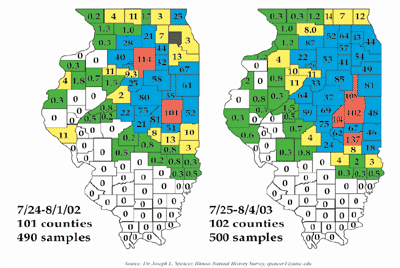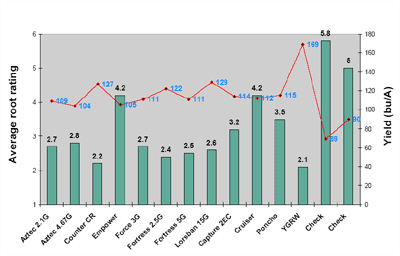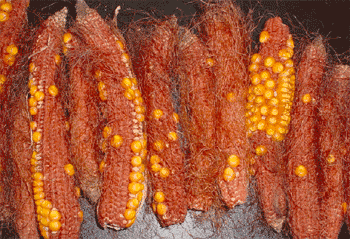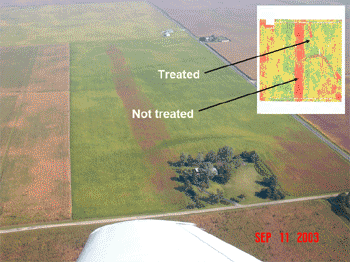The Changing Picture of Insect Management in Corn and Soybeans: New Tactics, New Invasive Pests, and Unknown Relationships
content
 |
Kevin L. SteffeyProfessor and Extension Specialist in EntomologyPhone: (217) 333-6652 E-mail: ksteffey@illinois.edu |
 |
Michael E. GrayProfessor and Extension Specialist in EntomologyPhone: (217) 333-6652 E-mail: megray@illinois.edu |
|
During the past several years, insect management has changed dramatically. The discovery of a variant western corn rootworm that lays eggs in crops other than corn has completely altered the way in which many producers manage this perennial pest. The perceived increase in the threat of secondary insect pests of corn (e.g., white grubs and wireworms) has encouraged producers to use insecticides for their control on more acres. The increased occurrence of Japanese beetle adults in cornfields has raised a lot of questions and concern about the pest's impact on yield. And the threat of an invasive species (soybean aphid) and an "old nemesis" (bean leaf beetle) has changed our thinking about managing soybean insect pests. In addition, exciting new technologies—transgenic Bt crops and insecticidal seed treatments—offer more tools for insect management. In fact, never before in the history of insect management have corn and soybean producers been able to select from such a diverse variety of insect management tools and tactics.
This presentation focuses on the significant insect challenges that occurred in 2003 and the management tactics and strategies to address these insect challenges in the future. Although the "headline insects" are emphasized, some "second-tier" insects are included in the course of discussing new insect-control technologies.
Western Corn Rootworms and Their Management
Variant Western Corn Rootworms
Variant western corn rootworms continue to extend their range in Illinois. Sweep-net samples of western corn rootworm adults in soybean fields were taken by Joe Spencer and Eli Levine (Illinois Natural History Survey) and Scott Isard (Department of Geography) again in 2003. They have been sampling western corn rootworm adults in soybeans for several years. The samples from 2003 revealed that western corn rootworms were found most frequently in soybean fields in east central, central, north central, and northeastern Illinois. The expansion of the range of variant western corn rootworms in Illinois in 2003 was most noticeable in northeastern counties and in counties south of Champaign County.
In 2002 and 2003, surveys of rootworm larval injury were conducted to track the distribution of the variant western corn rootworm that lays its eggs in crops other than corn. For the 36-county survey in 2003, we extracted five roots from each of 10 randomly selected fields within each pre-selected county. We had no knowledge of whether an insecticide had been applied or a transgenic Bt hybrid had been planted in any of the fields surveyed. All 1,800 roots were transported to Urbana, washed, and rated using the Iowa State 1–6 root-rating scale.
Maps, data, and additional information regarding the survey can be viewed at the "On-Farm Survey Results" page on the University of Illinois IPM Web site at http://www.ipm.illinois.edu/wcrsurvey/. County-specific information is featured at this site, including the relative location of each field within a county and the corresponding root ratings from that field.
Overall, results from the survey in 2003 revealed that the distribution of the variant western corn rootworm has spread farther northwest than was detected in 2002. The most severe rootworm larval damage in 2003 occurred east of a line extending northeast from Woodford County through DeKalb County. However, average root ratings in Lee, Marshall, and Stark counties were greater in 2003 than they were in 2002. Although Bureau and Ogle counties were not surveyed for rootworm larval damage in 2002, the average root ratings in these counties in 2003 were similar to the average root ratings in Lee, Marshall, and Stark counties.
The variant western corn rootworm still does not seem to be present in most counties west of the Illinois River. Average root ratings in Adams, Brown, and McDonough counties in 2003 were similar to average root ratings from similar surveys in these same counties in the mid- to late 1980s.
If producers in northwestern Illinois have not already begun to monitor for western corn rootworm adults in soybean fields, they should initiate monitoring in 2004. Guidelines for using yellow sticky traps to monitor for western corn rootworms in soybeans can be found on the University of Illinois IPM Web site. Results from western corn rootworm monitoring efforts should allow growers to determine the best management strategy for each field. Producers within counties in which severe rootworm larval damage has been detected for some time should continue efforts to determine whether western corn rootworm densities in soybeans indicate that control of larvae in corn the following year is necessary. Economic levels of rootworm larvae do not occur in every field.
Management of Corn Rootworms
Producers can select from a number of rootworm management tools and tactics—crop rotation, granular and liquid soil insecticides, insecticidal seed treatments, transgenic Bt corn, and controlling adults to prevent egg laying. However, the previously discussed adaptation by western corn rootworms has nullified annual rotation of corn and Producers can select from a number of rootworm management tools and tactics—crop rotation, granular and liquid soil insecticides, insecticidal seed treatments, transgenic Bt corn, and controlling adults to prevent egg laying. However, the previously discussed adaptation by western corn rootworms has nullified annual rotation of corn and soybeans as an effective rootworm management tactic in some areas of the state. As a result of this adaptation and the availability of so many control tactics, rootworm management is more complex and challenging than it was only 10 years ago.
Soil Insecticides and Seed Treatments. We conduct rootworm-control product efficacy trials annually at three sites in Illinois. Results from these trials have revealed that the granular formulations of Aztec, Counter, Force, and Lorsban provided the most consistent root protection. The performance of the liquid insecticides has been less consistent in our research trials, although the performance of Capture 2EC has been more consistent than the performance of Regent 4SC. Regardless of the insecticide used, performance can be compromised by early planting, delayed larval hatch, the presence of large numbers of corn rootworm larvae, poor root regeneration abilities of the corn hybrid, and hot and dry soil conditions.
The three insecticidal seed treatments labeled for control of corn rootworm larvae (i.e., Cruiser [a.i. is thiamethoxam], Force ST with ProShield Technology [a.i. is tefluthrin], and Poncho [a.i. is clothianidin]) also have been evaluated in efficacy trials for several years. In general, when rootworm densities and root injury have been moderate, seed treatments have provided acceptable protection of the roots. However, when rootworm densities have been high and root injury has been moderately high to severe, insecticidal seed treatments have not provided consistently acceptable control of rootworm larvae.
The root protection afforded by the Bt protein in YieldGard Rootworm corn hybrids (event MON 863) has been excellent in university and company trials for several years. Rootworm-protected Bt corn hybrids have provided more consistent protection of corn roots against rootworm larval damage than insecticides and insecticidal seed treatments in research trials.
Bt Corn for Rootworm Control. The insect resistance management plan for all Bt corn products (for management of either Lepidoptera pests or rootworms) to date includes a requirement for a 20 percent structured refuge of non-Bt corn. Corn hybrids with traits for resistance against both Lepidoptera pests and corn rootworms (e.g., YieldGard Plus) now are available.
Because of important biological differences between corn rootworms (mating is much more localized, and there is less mixing of adults from different fields) and European corn borers, the resistance management plan for YieldGard Rootworm corn hybrids has some unique features and includes the following elements:
-
Growers will be required to sign stewardship agreements if they purchase YieldGard Rootworm corn hybrids.
-
Growers will be required to plant a structured refuge of at least 20 percent non-Cry3Bb1 (MON 863) Bt corn.
-
The non-Bt corn refuge may be treated with insecticides to control corn rootworm larvae.
-
Refuge acres should be planted as blocks adjacent to fields of YieldGard Rootworm corn or as in-field strips within fields of YieldGard Rootworm corn.
-
Refuges planted as strips must be at least six rows wide, preferably 12 consecutive rows wide.
Growers who plant YieldGard Rootworm hybrids must comply with resistance management regulations if we expect to preserve use of this technology for the future of insect management.
The current Bt corn products for rootworm control do not control other subterranean insects such as white grubs and wireworms, pests for which rescue treatments are not effective. Consequently, all Bt corn for rootworm control will be treated with either Cruiser or Poncho.
Control of Secondary Insect Pests of Corn
The two nicotinoid seed treatments, Cruiser and Poncho, are garnering a great deal of attention. Both of these products are labeled for control of numerous "secondary" insect pests of corn, including, but not limited to, billbugs, cutworms, flea beetles, grape colaspis, seedcorn maggots, southern corn leaf beetles, white grubs, and wireworms, as well as for control of corn rootworms (the higher rates of each). Check the respective labels for more specifics.
The most important question regarding Cruiser and Poncho is: "Are these insecticidal seed treatments effective against the insects listed on the respective labels?" Considerable data regarding control of corn rootworm larvae with insecticidal seed treatments have been generated (previously discussed). Unfortunately, efficacy data for control of insects such as white grubs and wireworms are few and far between. And efficacy data for control of most of the other insects listed on the seed treatment labels are even more scarce. Although plenty of yield data have been generated, these data usually are not accompanied by any data associated with insect presence or injury caused by insects.
Each producer must ask whether an insecticidal seed treatment is necessary. The producer pays for the product, even when it may not be needed. (All YieldGard Rootworm corn hybrids will be treated with an insecticidal seed treatment; growers have no other option.) Consequently, producers will have to pay for both the Bt technology and the seed treatment. Is the added expense necessary? Do growers need to apply insecticides to many corn acres for control of insects that may not be present? In some respects, we are returning to the days of using soil insecticides without knowledge of the presence of insects.
Are Japanese Beetles Affecting Corn Yields?
In recent years, Japanese beetles feeding on corn silks during pollination have caused a great deal of concern. However, we have little knowledge about the impact of silk clipping by Japanese beetles on corn yield. The current economic threshold to prevent Japanese beetles from interfering with corn pollination is three beetles per ear. However, this threshold is debatable, its origin lost in antiquity.
Sampling for Japanese beetles to make a decision about whether an insecticide application is necessary is a challenge. Through the action of pheromones emitted by Japanese beetles, the distribution of these insects within fields usually is highly clumped, often most noticeable in field edges. This probably occurs as the very active beetles move from their areas of emergence from the soil to the most attractive flowering plants (and pheromone-emitting females) in the vicinity. Consequently, densities of Japanese beetles within a field will be overestimated if the sample is taken only where clumps of these pests occur. Although infestations of Japanese beetles may look overwhelming in one or a few areas within a field, it is possible that the average density of the beetles for the field is below a level of economic concern. Before rushing to judgment about the need to control Japanese beetles, producers should have a good sense of the distribution of the pest throughout a field.
The Soybean Aphid Outbreak of 2003 and Management Suggestions for 2004
In 2003, soybean aphid densities reached significant, yield-threatening levels in northern and central Illinois. Based on estimates obtained from members of the Illinois Agricultural Aviation Association and our own observations, we believe that 750,000 to 1 million acres of soybean were treated with an insecticide to control soybean aphid in Illinois in 2003, about 7 to 10 percent of the total soybean crop (an estimated $9 to $12 million in treatment costs, assuming an average of $12 per acre). We believe that 75 to 80 percent of the treatments were applied by air, and most treatments occurred after mid-July. Although yield loss estimates are still being determined, at least one estimate of yield loss caused by the soybean aphid in 2003 is $45 million. Although other yield-reducing factors undoubtedly were involved, much of the lower-than-expected soybean yields in Illinois in 2003 were blamed on the impact of soybean aphids, resulting in fewer pods per plant and smaller beans in the pods.
Treatment guidelines (including economic thresholds) had to be altered in 2003. Data from other universities had indicated that the primary threat of soybean aphids to yield occurred when aphid infestations were heavy during the R1 and R2 stages of development. However, many heavy infestations in Illinois in 2003 occurred when the stage of development was R4, R5, or R6. We had no experience with such late-developing infestations of soybean aphids; consequently, makeshift thresholds, based upon limited experience, were generated: 250 or more aphids per plant during R1 or R2; 1,000 or more aphids per plant during R3; and 1,500 or more aphids per plant during R4 or R5.
Were these thresholds accurate? We won't know the answer to this question until more data are gathered and summarized. However, based upon information we have received from producers and agricultural industry representatives, yield benefits were more substantial if soybean aphids were controlled during the R1 or R2 stages than during the R4 or R5 stages. As we learn more about this invasive species over time, the treatment guidelines will be adjusted accordingly.
Tables & Figures
 |
Figure 1. Charcoal
rot and microsclerotia of the charcoal rot fungus on a soybean
stem. |
 |
Figure 2. Root rot and top dieback
of soybeans in 2003. |
 |
Figure 3. Poor kernel set caused by Japanese
beetle adults clipping silks in Sangamon County. (Provided by Matt Montgomery, Sangamon County Extension). |
 |
Figure 4. Soybean field with insecticide-treated
and non-treated areas, Illinois, September 11, 2003. |